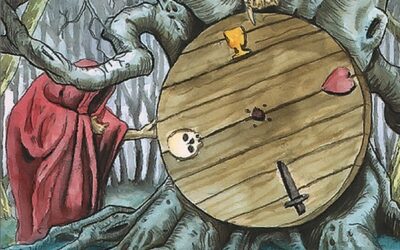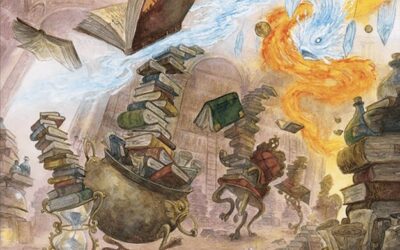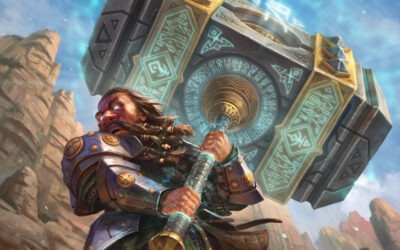Hey everyone, I’m A_AdeptoTerra, in the last month I had 2-3 results in Competitive Leagues and Challenges with a Temur list of Dinrova Tron.
I also made two top8 in a 7+ turns paper Pauper tournament with these lists:
Italian National 2017 – Pauper Cup (Simic list)
Paupergeddon Milan 2019 (Fire//Ice decklist)
Dinrova Tron by A_AdeptoTerra, 5-0 Competitive Pauper League
| Creature (8) 2 Dinrova Horror 2 Mnemonic Wall 4 Mulldrifter Spell (29) 1 Compulsive Research 1 Rolling Thunder 1 Crop Rotation 1 Doom Blade 1 Exclude 4 Fire // Ice 2 Forbidden Alchemy 2 Ghostly Flicker 2 Moment’s Peace 2 Mystical Teachings 2 Prohibit 2 Pulse of Murasa 1 Unwind 3 Expedition Map 4 Prophetic Prism Land (23) 1 Bojuka Bog 1 Island 1 Remote Isle 3 Swiftwater Cliffs 3 Thornwood Falls 2 Unknown Shores 4 Urza’s Mine 4 Urza’s Power Plant 4 Urza’s Tower | Sideboard (15) 1 Doom Blade 1 Moment’s Peace 1 Ancient Grudge 2 Dispel 1 Electrickery 2 Hydroblast 3 Pyroblast 2 Stonehorn Dignitary 2 Obsidian Acolyte |
Decklist choices
We are playing in a midrange-heavy format, so I always assume that the more represented decks in a tournament or League will be Boros Monarch, Boros Bully and Dimir Delver (maybe even Burn, at times). Due to this, in my opinion it isn’t a good choice to rely too much on Ghostly Flicker. Additionally, I do believe that having a more proactive gameplan is better against Ux Delver.
Creatures
I am not playing Sea Gate Oracle because I want to spend the first turns developing the manabase and/or my hand with high-impact spells. We need to pack at least three copies of SGO to deploy one of them in the first stage of the game – something which would require using several slots in the mainboard.
Mnemonic Wall: I play only two copies of our favourite Wall because, in a Delver metagame, we don’t have time to build the fog lock or a counter/removal lock. Also: we usually spend the early and midgame answering the opponent’s threats. I replaced the third wall for a Compulsive Research, which gives the deck some card advantage and is more versatile overall.
Spells
The right amount of counterspells depends on the metagame and also on how you want to play the deck. If you want to have a “full-combo” gameplan and using Ghostly Flicker to lock the opponent, two or three counterspells are a fine option. As for me, I prefer a more interactive approach because I value flexibility (also due to playing in paper tournaments, which don’t have a very defined metagame).
My favourite split is two Prohibits, one Remove Soul effect, one generic counterspell and one or two multi-purpose ones. In a field filled with Delver decks, I’d reccomend three or four counterspells (e.g. Two Prohibit and one Exclude, 1 counter of your choice).
Prohibit is the best maindeck counterspell available thanks to the wide range of two or less-cmc spells played in Pauper. We can play up to two copies of it.
Unlike you what might think, Condescend is probably the worst counter, so I gave it the boot. It is the perfect answer on the stack in the late game thanks to the Urza lands, but does poorly in the early game. Also: we often don’t have enough mana to cast it in a fast metagame.
I prefer the fourth copy of Fire//Ice gets the nod instead, as it is more flexible. Tapping a land is a fine second turn play for example.
In my opinion, one Exclude (or similar) is a necessity. Creatures like Palace Sentinels, Mulldrifter or Mnemonic Wall are problematic and the card is the closest maindeckable thing to Pyroblast.
Unwind went in instead of the maindeck Dispel. It is a good countermeasure in a field filled with Boros Monarch, besides being one the best protection spells when I deploy a huge treath (i.e. Mnemonic Wall or Dinrova Horror). Untapping enough colored mana allows to play another card (oftentimes Ghostly Flicker) to get even more advantage.
Crop Rotation allows to have a tutorable Urzaland via Mistical Teachings. It is also an instant-speed Bojuka Bog, which is crucial tin removing Mnemonic Wall targets or cards with Flashback (e.g. Prismatic Strands) or Retrace (e.g. Raven’s Crime).
Fire//Ice is the best maindeckable answer against Elves and Faeries, some the decks’ worst match-ups. Dealing with an early Timberwatch Elf, Faerie Miscreant or Ninja of the Deep Hours is very relevant, but Twin Bolt isn’t equally good against, for example, the mirror match or Boros Monarch (despite the presence of Battle Screech). The option to cycle a card that would otherwise be dead is definitely relevant: tapping the opponent’s mana (in upkeep or in the end step) or a creature before the combat (Gurmag Angler?) equals to tempo advantage. Alternatively, tapping the opponent’s Island might be key to resolve a Mulldrifter.
Doom Blade is the card that solves key problematic creatures such as Atog, Tireless Tribe, Timberwatch Elf or Nivix Cyclops. Why not Rend Flash, Lightning Axe or Ob Nixilis’s Cruelty, you might ask? In my opinion, Dimir Delver is a more favorable matchup in game one than the decks playing the threats above, so I prefer relegating cards like Lightning Axe in postboard games.
Lastly, Rolling Thunder is one of the most important cards you can play in a long games deck. The worst thing for a control deck is not having a clock or a finisher and RT is a better version of Evincar’s Justice, so gotta roll’em all.
Sideboard
Ancient Grudge: the main purpose of this card is to destroy Relic of Progenitus and Nihil Spellbomb. Somentimes we board it in just to have another removal spell against Myr Enforcer, Bonesplitter or Spire Golem.
Stonehorn Dignitary is a better version of Moment’s Peace, I play it just to have four to five fog effects against Aggro.
Ulamog’s Crusher is a one-card sideboard plan against Boros Monarch, Flicker Tron (not Fangren Tron) and sometimes against Izzet Midrange and Control. I kept it in my latest list because the current meta is light in the amount of Flicker Tron and Boros sometimes don’t play conservatives and isn’t very good if they push the Aggro side of the deck. (non ho capito cosa intendi)
Obisidian Acolyte is, in my opinion, the best thing we can play against Dimir Delver to deal with Gurmag Angler. I came up to this conclusion based on the fact that we can easily play around Delver of Secrets, but there doesn’t seem to be an ideal hate card to destroy or lock the black Zombie fish.
- Lightnning Axe: discarding a card is problematic in early, plus they board in Dispel and often Hydroblast against us.
- Narcolepsy / Curse of Chains: a two-mana sorcery speed spell that only stops a single creature. Plus, it gets foiled by Annul.
- Harvest Pyre, Spontaneous Mutation: an instant-speed answer is surely sweet (given Mystical Teachings), but these cards require graveyard presence and Relic of Progenitus is a sideboard staple. Also: Dispel and Annul, once again.
- Circle of Protection: Black needs white mana, but it is one of the better answers to a vanilla 5/5 black creature. There are two problems: we can’t take back it from the graveyard and – you’ll have figured that out by now – Annul.
Obsidian Acolyte is very versatile. We can Pulse it back (even after having milled it with Forbidden Alchemy). It can counter Snuff Out and Soul Reap. In the late game, we don’t have problems paying white mana to provide pro: black to other creatures to block the others Anglers on the board. In my opinion, an important thing is that the opponent can’t counter the Acolyte with a one-mana counter, so it gets down to Counterspell or a Foil.
Some side-in/-out tips
The outcome of many match-ups depend, among other things, on what of kind of player you are and how you want play the deck.
Dimir Delver: tied
The match up depends on how skilled out opponent is and on what they boarded in the post-side game. In g2 and g3 it’s difficult to win via the Ghostly Flicker loop, so it is more profitable trying to kill Delvers and Anglers. You don’t want to rely on the Flicker part of the deck, I’ll suggest this side-out:
Side-out: overcosted counterspells (Exclude, Unwind, Condescend, Prohibit), 1 Ghostly Flicker, 1 Moment’s Peace, Doom Blade (or the second Moment’s Peace).
Side-in: Dispel, Pyroblast, Ancient Grudge (probably they have Relic), Obsidian Acolyte.
Alternatively, you can just switch the counters and rely more on the fog lock aspect (Dimir Delver isn’t good in the long game), but post-board they try to win as fast they can, usually disrupting our manabase with Annul or Daze and putting a fast threat. Obviously, Daze isn’t typically a good card against Tron, but we need to play keeping in mind that they probably might have kept it in.
Problematic cards: Counterspell, Dispel, Foil. Foil, in particular, can generate a lot of tempo advantage and they might tempo us out very well when they have several of them in their hand.
Burn: favorable or at least tied
How it’s possibile? And whitout playing Circle of Protection: Red?
Well, Burn is a Lava Spike Combo, that means that’s needs a critical amount of spell to win. In this matchup, we don’t play like an Urzatron deck; rather, we play as a blue-red control and the gameplan revolves around slowing them down by countering burn spells in the dead turns and to run away with the match in the late game.
Basically we win thanks to a critical amount of counterspells. In the lategame, they’ll likely have no cards left in their hand, and we have 10 or more lifepoints left.
Problematic cards (pre-side): Thermo-Alchemist, Curse of the Pierced Heart, Fireblast
Problematic cards (post-side): Molten Rain on the draw, Smash to Smithereens.
Side-in: Dispel, Hydroblast, removal spells, Circle of protection: red if you have it.
Side-out: Rolling Thunder, Moment’s Peace, Exclude (often a dead card) and Dinrova Horror if we need another or two slots.
A tip: aim to prioritize colored lands and play around Molten Rain and Smash to Smitherens with Ghostly Flicker and Crop Rotation if possible.
Boros Monarch: favorable
Problematic cards: Palace Sentinels, Bojuka Bog, burn spells (sometimes Seeker of the Way).
Make sure to not let Palace Sentinels resolve in the early stage of the game if you can’t steal the Monarch back right away. Fire//Ice is good in game 1 to tap a land (maybe a bounceland), which can prevent the four-drop from being landed. Another good thing is playing Dinrova Horror on turn four if we are on the play and the opponent can’t kill it right away with a Galvanic Blast, because we set the opponent’s development back and they can’t deploy the Monarch card.
Post side MVPs are cards like Fangren Marauder or Ulamog’s Crusher, which require different answers than Pyroblast or Relic of Progenitus. They may keep Journeys in, but that’s a shaky solution due to the presence of Dinrova Horror.
The sideboard plan in this match-up depends on how aggressively the opponent plays.
If they go for the card advantage ruote and rely on Relic of Progenitus and other hate cards, we usually don’t need Doom Blade or a large number of Fire//Ice and the Wall+Flicker value plan is the best (or even the Dinrova plan if they don’t have enough creatures or removal spells to kill us). Against this kind of gameplan, the ideal side-in cards are Ancient Grudge, Ulamog’s Crusher and Fangren Marauder. I don’t really appreciate Dispel and Hydroblast, they can’t answer Relic of Progenitus, Battle Screech or Palace Sentinels.
If the opponent plays very greedily, skipping on card draw and land-drops (e.g. by bouncing lands back to their hand with Skyfishers and Hawks), the best choice is playing more removal spells to slow them down until they reach topdeck mode and are left with no creatures. Alternative side-in cards, in this case, might be Electrickery and Doom Blade effects.
Izzet Delver: unfavorable
Problematic cards: Ninja of the Deep Hours, Spellstutter Sprite.
Mulldrifter is the best card here. You’ll often win by recurring Drifters with Pulse of Murasa and chumpblocking the opponent’s threats over and over again.
Prioritize destroying Faeries and Ninja. Countering Augur of Bolas is a good thing to prevent Ninja from entering the battlefield. Don’t fall into Spellstutter Sprite unless you can’t play around it.
Colored lands are more relevant than Urzalands: we need at least 2 or 3 blue mana to play our game well.
Side-in: Electrickery and other removals, Ancient Grudge (they often have Relic of Progenitus), Pyroblasts.
Side-out: Moment’s Peace (not very helpful – removal spells are better), Crop Rotation (due to Spellstutter Sprite), overcosted counterspells, Dinrova Horror (not many valid targets and it costs lots of colored mana).
Mono U Delver: unfavorable
Same considerations and side-in/-outs as for UR Delver and, but a worse match-up.
Try to play around Daze. Also note that Ancient Grudge can be brought in to destroy Spire Golem and Bonesplitter if they play it/them.
Boros Bully: favorable
Problematic cards: Seeker of the Way, Palace Sentinels
Usually they have close to no reach (i.e. burn spells), so it is a better matchup than Boros Monarch.
Due to their more aggressive nature, cards like Moment’s Peace are more valuable.
The big problem here lies in understanding what to side out. They play different kind of threats: an aggro gameplan with Seeker, Battle Screech and Rally the Peasant and a grindy one with Palace Sentinels. The better thing is probably cutting some situational cards to bring in more answers to the aggro gameplan.
Side-out: I still need to figure it out.
Side-in: Ancient Grudge, Doom Blade (for Seeker) and maybe Stonehorn Dignitary (they sometimes play Flaring Pain). Be sure to not cut Dinrova Horror, because they usually keep the Journeys in.
Aura Hexproof: tied, because they’re mad horses
Jokes aside, the MU depends on how fast they start.
The better gameplan is to have a huge number of effects to stop their combats, so that’s one of the reasons to play cards like Stonehorn Dignitary in the sideboard.
Side-in: Electrickery, Moment’s Peace, Stonehorn Dignitary
Side-out: Rolling Thunder, Exclude, Doom Blade, 1 Prohibit
Fire//Ice is more helpful than I thought- tapping an enchanted land in their upkeep in the first turns gives us an extra turn to set the Urza Tron or to dig in the library by delaying their haymaker Auras from landing.
Dinrova Horror is a valid finisher. Recoiling an Ancestral Mask or an Ethereal Armor during the combat step is something similar to a lifegain/fog effect (or sometimes a straight up one-for-one trade with their Bogle).
One or two counterspells are required post-board due to the Flings, Relics and/or Dispels they might be playing.
Flicker Tron
An interesting matchup. You need some practice to learn how to play it, base you’ll have a different approach according to the situation at hand- which is stimulating (at least for me).
Side-in: Dispel, Pyroblast, Doom Blade (to kill Ulamog’s Crusher or Mnemonic Wall from starting the Flicker engine).
Ancient Grudge to destroy Prophetic Prism or other mana rocks is too situational for my taste.
Hydroblast is a counter to their counters (aka Pyroblast), so I prefer to skip on it.
Side-out: fogs, Fire//Ice (tapping a land or a Prism isn’t relevant and we have more hellpfull cards post-side, Dispel for example), Rolling Thunder (if you don’t have Ulamog’s Crusher and are under time you may think to kept in, but it’s an overcosted finisher in this MU, so it’s difficult having an open window).
Other Aggro decks: (generally) favorable
As a general blueprint I suggest the following:
Side-in: fogs
Side-out: slow counterspells.
Affinity is a toss-up, as it can land very fast starts and Atog is a problematic threat.
RDW is a negative matchup: a lot of 2/2 creatures, burn spells and pump spells. They just put a lot of hasty creatures that are difficult to deal with without one-mana removal spells. Cards like Fireblast or Lightning Bolt mess up the life count.
Izzet Kiln, UW Tribe: unfavorable
Probably the worst match-ups of all. We need to prioritize interaction, so be sure to have a fair amount of answers and colored mana to play the game.
I usually prefer to not go overboard with fog effects, as playing removal spells is a safer route and it gives us more time.
Unwind is the best answer to Gigadrowse, so keep that in mind.
If you want to discuss any specific matchup, feel free to hit me up!













